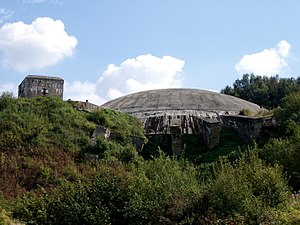Operation Crossbow
|
World War II Operation Crossbow vs Eisbär (V-1) & Pinguin (V-2) |
|||||||
|---|---|---|---|---|---|---|---|
| Part of Strategic bombing campaigns in Europe | |||||||
 La Coupole (Wizernes) "Heavy Crossbow" target |
|||||||
|
|||||||
| Belligerents | |||||||
|
|
|
||||||
| Strength | |||||||
|
Sorties/bomb tonnage: |
V-1 launches: 9,251 against 2,448 @Antwerp V-2 launches: 1664 1402 11 |
||||||
| Casualties and losses | |||||||
|
Airmen/aircraft:
British civilians killed/
|
V-1: 4,261 destroyed 48/69 rockets/vehicles damaged |
||||||
| USSBS Crossbow Exhibits |
Sorties/bomb tonnage:
Total: 68,913/122,133
RAF: 19,584/72,141
Airmen/aircraft:
British civilians killed/
seriously injured:
V-1: 4,261 destroyed
by AA guns (1,878),
barrage balloons (231),
and fighters (1,846):
Crossbow was the code name of the World War II campaign of Anglo-American "operations against all phases of the German long-range weapons programme. It included operations against research and development of the weapons, their manufacture, transportation and their launching sites, and against missiles in flight".
The original 1943 code name Bodyline was replaced with Crossbow on November 15, 1943.Post-war, Crossbow operations became known as Operation Crossbow as early as 1962, particularly following the 1965 film of the same name.
In May 1943 Allied surveillance observed the construction of the first of 11 large sites in northern France for secret German weapons, including six for the V-2 rocket. In November it discovered the first of 96 "ski sites" for the V-1 flying bomb. Officials debated the extent of the German weapons' danger; some viewed the sites as decoys to divert Allied bombers, while others feared chemical or biological warheads. When reconnaissance and intelligence information regarding the V-2 became convincing, the War Cabinet Defence Committee (Operations) directed the campaign's first planned raid (the Operation Hydra attack of Peenemünde in August 1943).
...
Wikipedia
